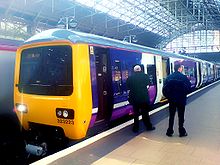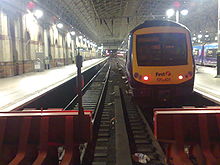- Manchester Piccadilly station
-
Manchester Piccadilly 
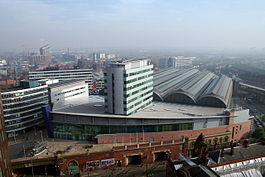
Location Place Manchester city centre Local authority City of Manchester Coordinates 53°28′37″N 2°13′48″W / 53.477°N 2.230°WCoordinates: 53°28′37″N 2°13′48″W / 53.477°N 2.230°W Operations Station code MAN Managed by Network Rail Number of platforms 14 (National Rail)
2 (Manchester Metrolink)Live arrivals/departures and station information
from National Rail EnquiriesAnnual rail passenger usage 2004/05 *  18.959 million
18.959 million2005/06 *  21.231 million
21.231 million2006/07 *  14.514 million
14.514 million2007/08 *  20.656 million
20.656 million2008/09 *  22.026 million
22.026 million2009/10 *  19.841 million
19.841 millionPassenger Transport Executive PTE Greater Manchester Zone City (D) History 1842 Opened 1960 Renovated 2002 Renovated National Rail - UK railway stations A B C D E F G H I J K L M N O P Q R S T U V W X Y Z * Annual passenger usage based on sales of tickets in stated financial year(s) which end or originate at Manchester Piccadilly from Office of Rail Regulation statistics. Please note: methodology may vary year on year. Manchester Piccadilly (Manchester London Road until 1960) is the principal railway station in Manchester, England. It serves intercity routes to London Euston, Birmingham New Street, South Wales, the south coast of England, Edinburgh and Glasgow Central, and routes throughout northern England. Two platforms for the Manchester Metrolink light rail network are located in the station's undercroft. Piccadilly is one of 18 British railway stations managed by Network Rail.
Piccadilly is the busiest station in Manchester ahead of Manchester Victoria and Manchester Oxford Road. It is the fourth busiest station in the United Kingdom outside London,[clarification needed] after Birmingham New Street, Glasgow Central and Leeds.[1][2] According to Network Rail, which manages it, over 28.5 million people use the station annually.[2]
The station received a five-year £100m refurbishment in 2002, which was the most expensive improvement on the UK rail network at the time.[3] According to an independent poll carried out in 2007, Manchester Piccadilly has the highest customer satisfaction level of any UK station, with 92% of passengers satisfied with the station; the national average was 60%.[4]
Contents
History
The station opened on 8 May 1842 as Store Street station and as Bank Top station, terminus of the Manchester and Birmingham Railway, which shared it from August 1844 with the Sheffield, Ashton-under-Lyne and Manchester Railway.
Manchester London Road
The station was renamed London Road station in 1847, around the time the Manchester, Sheffield and Lincolnshire Railway was formed (later to become the Great Central Railway). The Manchester, South Junction and Altrincham Railway (MSJAR) opened its line from Manchester Oxford Road railway station to London Road on 1 August 1849 and built its own platforms adjacent to the main part of the station. These platforms were referred to as the MSJAR or South Junction platforms. During the early 1880s the station was enlarged. The MSJAR platforms and the bridge over Fairfield Street were demolished and an island platform, on girder bridges, opened on 16 May 1882.
During the first two decades of the 20th century, London Road station was served by the London and North Western Railway, the Great Central Railway and, through running powers, the North Staffordshire Railway. Following the 1923 railway grouping, the station was served by the London, Midland and Scottish Railway and the London and North Eastern Railway. After nationalisation in 1948, London Road station was operated as two independent sides, separated by formidable iron railings located where platform 5 now is. On one side was the London Midland Region of British Railways; on the other was the Eastern Region.
In 1910 a second terminus, Mayfield Station, was opened to cope with passenger volume. It was closed to passenger trains by 1952 but remained in use until August 1960 for "overflow" local services and for one major passenger train, the Pines Express from Bournemouth to Manchester. It reopened as a parcels depot in 1970 but has since closed. Its disused building is visible across Fairfield Street from platforms 13 and 14.[5]
Manchester Piccadilly
London Road station was renamed Manchester Piccadilly after rebuilding and it reopened on 12 September 1960 for London Midland Region electric train services to London. The MSJAR platforms and the bridges over Fairfield Street were replaced at this time. The island platforms (13 and 14) were built on top of a new pre-stressed concrete slab bridge with cantilevered sides for the tracks.
In the early 1970s, as part of the Picc-Vic tunnel project, there were proposals to build an underground station, Piccadilly Low Level.[6] The project was cancelled, and subsequent rail improvements concentrated on surface projects and the introduction of light rail.
Piccadilly's island platforms were further rebuilt and lengthened in 1988 in connection with the opening of the Windsor Link. The glass roof over the terminal platforms was completely replaced in the late 1990s. The train shed is a Grade II listed building.
In 2001-2002, as part of preparations for the 2002 Commonwealth Games the remainder of the station was rebuilt, to designs by BDP, increasing the size of the concourse and improving road access. The station's undercroft (the two levels below the main rail platforms) were converted to provide two platforms for the Manchester Metrolink tram system, which opened in 1992.
Future
Network Rail's 'Northern Hub' plans, at a cost of over £560 million, which aim to improve the heavily congested rail network around Manchester were revealed in 2011. Two new platforms would be constructed at Piccadilly and the station linked to Manchester Victoria via the 'Ordsall Chord', a new line costing £85 million, cutting journey times on Trans-Pennine routes.[7][8]
Description
National Rail station
The terminal consists of 12 platforms, which house terminating/originating services with a longer stopover, while the busiest part of the station consists of platforms 13 and 14, the former MSJAR platforms, now used by through services via Manchester Oxford Road to North Wales, Liverpool, North-Western England, Glasgow and Edinburgh, including through services from Manchester Airport and split into a and b sections to allow more than one train to stand at a time. These through services have shorter dwell times.
Metrolink station
Piccadilly
Manchester Metrolink 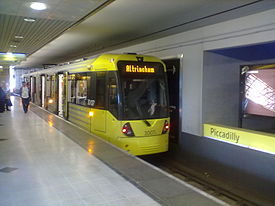
Piccadilly Metrolink station Location Place Manchester city centre Local authority Manchester Platforms 2 Fare zone information Metrolink Zone D (City) Conversion to Metrolink operation 4 June 1992 to Bury 

to Rochdale 


Victoria 






Second City Crossing 


Shudehill 


High Street Exchange Square 


Market Street 


Mosley Street 


Piccadilly Gardens 


Piccadilly 
St Peter's Square 


to Ashton-under-Lyne D'gate-Castlefield 


(  Deansgate)
Deansgate)





Cornbrook to MediaCityUK and Eccles 


Trafford Bar 





to East Didsbury and to Altrincham 

Manchester Airport  UK Trams portal
UK Trams portalManchester Piccadilly station is currently the terminus for Manchester Metrolink services to Bury, Altrincham, and Eccles. A service to St Werburgh's Road commenced in March 2011. The Metrolink station, in a vaulted undercroft underneath the mainline station, is one of eight serving Manchester city centre, within the system's City Zone. Trams from Piccadilly Gardens run down Aytoun Street, cross on to London Road and run a short distance on segregated track, before crossing the road and entering the undercroft through a tunnel entrance.
The station is the busiest on the Metrolink network.[citation needed] Under current arrangements, there are separate arrivals and departures platforms; after arriving passengers disembark, the empty tram runs into a reversing siding in a tunnel, where it reverses and runs up to the departure platform.[9] Previously one platform was used for arrivals from Altrincham/departures to Bury, and the other for arrivals from Bury/departures to Altrincham and all services to/from Eccles, with a crossover inside the station to allow access to and from either platform.
The tram station has been refurbished, and was the first to display the new Metrolink corporate identity unveiled in 2008.[10] Station signage bears the yellow and silver livery as applied to the new generation of trams since 2009.[11]
Piccadilly is the eastern terminus of the Metrolink system, but the track was constructed with eastward extension in mind. Proposals have been approved for a six-mile extension to Ashton-under-Lyne.[12] The reversing sidings will form part of this line, which will run out of the north side of the station through Ancoats, Sportcity, Clayton, and along Ashton New Road to Droylsden and Audenshaw.[13] Trams terminating at Piccadilly from the city centre will use a new reversing siding being built to the east side of Sheffield Street.
In the early 1980s, proposals for a light rail system were based on converting existing railway lines to light rail operation (as with the Altrincham and Bury lines). Under these plans, eastward extensions from Piccadilly would have involved running Metrolink trams along the Glossop Line (to Hadfield and Glossop) and along part of the Hope Valley Line (to Marple and Rose Hill). These plans are no longer being pursued; however, the alignment this route would have used is still protected in 2010, with BRB Residual land disposals being altered by the ORR after a year-long consultation.[citation needed]
-
Piccadilly Metrolink stop. Refurbished in late 2009, it displays the new Metrolink brand identity.
Facilities
Railway Clearing House diagram of railways in Manchester in 1910
The Fairfield Street entrance, at basement level, serves the car park, taxi rank, and the Metrolink station. Above, at track level, is a concourse into which the main entrance feeds. It houses ticket offices, information points, seating, timetables, toilets, shops, and food and drink outlets. Above the concourse is a second level of food outlets and bars, and the Virgin Trains First Class Lounge. On the main concourse, glass doors within a large glass screen lead to platforms 1 to 12. A travelator leads to the upper concourse linked by footbridge, steps and lift to platforms 13 and 14. The island lounge contains retail outlets, toilets and a departure lounge. There are vending machines, waiting areas and snack bars on platforms 13 and 14.
Manchester Piccadilly is accessible for disabled people and has escalators and lifts to all levels, wide access doors and gates, braille signs and hearing loops and disabled toilet facilities.
Cycle racks are available on Fairfield Street, the long stay car park and next to the tower block at the station front. In March 2010, Manchester City Council and Network Rail unveiled plans for a 'Cycle Centre' to provide secure facilities, with maintenance and hire facilities.
There is a taxi rank and short stay car park allowing limited free parking for pick up and drop off passengers and a multi-storey car park to the rear of the station [14]
Services
Manchester Piccadilly is currently served by six train operating companies.
- Local train services to stations in the Manchester area, primarily to destinations to the south and east of the city in Cheshire or Derbyshire and beyond. These include Hadfield, Marple, Rose Hill Marple, New Mills Central, Sheffield via New Mills Central, Hazel Grove, Buxton, Crewe via Stockport or Manchester Airport, Stoke-on-Trent via Macclesfield, and Chester via Altrincham and Northwich
Services also operate to the north and west of the city, via the towns to the north and west of Manchester to places such as Liverpool via St Helens Junction, Preston via Bolton and Southport via Wigan.
These are operated by a variety of trains of Class 142, Class 150 and Class 156 Sprinter DMUs, Class 180 or Class 323 electric units.
- Hourly services via Chester and the North Wales Coast Line to Llandudno, calling at Manchester Oxford Road, Newton-le-Willows, Earlestown, Warrington Bank Quay, Runcorn East, Frodsham, Helsby, Chester, Shotton, Flint, Prestatyn, Rhyl, Abergele & Pensarn, Colwyn Bay, Llandudno Junction, Deganwy and Llandudno
- Hourly services via Shrewsbury and the Welsh Marches Line to Cardiff Central, with many services continuing to Carmarthen or Milford Haven. Class 175 Coradia units operate almost all of Arriva Trains Wales' services out of Manchester, with Class 158 and Class 150 units occasionally substituting.
- Daily services to Birmingham and Cardiff via Chester, Wrexham and Shrewsbury.
- Hourly services to Bournemouth, calling at Stockport, Macclesfield, Stoke-on-Trent, Stafford, Wolverhampton, Birmingham New Street, Birmingham International, Coventry, Leamington Spa, Banbury, Oxford, Reading, Basingstoke, Winchester, Southampton Airport (Parkway), Southampton Central, Brockenhurst and Bournemouth.
- Hourly services to Bristol Temple Meads, calling at Stockport, Stoke-on-Trent, Wolverhampton, Birmingham New Street, Cheltenham Spa, Bristol Parkway and Bristol Temple Meads, with some trains extended to destinations in Devon. All CrossCountry services operate using Voyager DMUs, except in the summer when there is one HST per day to Newquay.
- Hourly service from Liverpool Lime Street via Piccadilly to Sheffield and Nottingham, with most trains continuing to Norwich. Class 158 Express units are used for these services. Class 222 units are also occasionally used for additional capacity at times of special events.
First TransPennine Express operate services on three routes.
- The North TransPennine route has a quarter-hourly service to Leeds via Huddersfield, with one train per hour continuing to each of Hull, Newcastle, Middlesbrough and Scarborough. In the opposite direction, one train per hour continues from Piccadilly to Liverpool Lime Street and two to Manchester Airport. A two-hourly service to Leeds and York operates after midnight, providing a 24-hour service.
- The South TransPennine route runs from Manchester Airport via Piccadilly to Sheffield and Cleethorpes, operating every hour.
- The TransPennine North West services run from Manchester Airport via Piccadilly to Preston via Bolton and Chorley every half-hour, with trains continuing to Blackpool North every hour, and each of Barrow-in-Furness and Windermere every two hours, as well as continuing to Edinburgh Waverley and Glasgow Central, some of which are combined with services to Windermere, Blackpool North and Barrow-in-Furness.
Class 185 Desiro units now work the majority of these services, replacing the class 158s on the North and South services, and the class 175s on the North West services. Most of the Manchester-Hull services are operated by Class 170 Turbostar units.
- Three trains per hour to London Euston via Stoke-on-Trent or Crewe as part of the West Coast franchise, operated with Pendolino trains.
- Limited services to Birmingham New Street operated by Super Voyagers.
 National Rail
National RailArriva Trains Wales Terminus Terminus Arriva Trains Wales East Midlands Trains Liverpool-NorwichFirst TransPennine Express First TransPennine Express First TransPennine Express Northern Rail Terminus Northern Rail Northern Rail Manchester-Glossop LineTerminus Northern Rail Northern Rail Northern Rail Northern Rail Liverpool-Manchester LineTerminus Northern Rail Manchester-Preston LineNorthern Rail Terminus Northern Rail CrossCountry Terminus CrossCountry Terminus Virgin Trains Terminus Preceding station Manchester Metrolink
Following station towards AltrinchamAltrincham - Piccadilly Line Terminus towards BuryBury - Piccadilly Line towards EcclesEccles - Piccadilly Line Under Construction TerminusEast Manchester Line towards Ashton-under-LyneReferences
- ^ Delta Rail (March 2010). "2008-09 station usage data" (Microsoft Excel). Office of Rail Regulation. http://www.rail-reg.gov.uk/upload/xls/station_usage_0809.xls. Retrieved 2010-08-28.
- ^ a b "Footfall Figures" (pdf). Network Rail. p. 1. http://www.networkrail.co.uk/documents/5318_Footfall%20figures%20for%202007.pdf. Retrieved 2010-08-28.
- ^ "£100m station revamp opens". BBC. 9 December 2002. http://news.bbc.co.uk/1/hi/england/2556527.stm. Retrieved 2011-09-04.
- ^ "Revamped station tops train poll". BBC News Online (London). 2 August 2007. http://news.bbc.co.uk/1/hi/england/manchester/6927406.stm. Retrieved 2008-09-17.
- ^ Sutcliffe, Paul; Catford, Nick. "Disused Stations: Closed Railway Stations in the UK". http://www.subbrit.org.uk/sb-sites/stations/m/manchester_mayfield/index.shtml. Retrieved 2008-09-17.
- ^ SELNEC Picc-Vic Line, SELNEC PTE, October 1971 publicity brochure
- ^ "Have your say on Network Rail's £560m plan to improve rail travel in Greater Manchester". Manchester Evening News. 7 October 2011. http://menmedia.co.uk/manchestereveningnews/news/transport/public_transport/s/1461134_have-your-say-on-network-rails-560m-plan-to-improve-rail-travel-in-greater-manchester. Retrieved 2011-10-07.
- ^ "The Missing Link: Rail line between Manchester Piccadilly and Victoria stations to boost jobs and business". Manchester Evening News. 5 April 2011. http://menmedia.co.uk/manchestereveningnews/news/business/s/1417173_the-missing-link-rail-line-between-manchester-piccadilly-and-victoria-stations-to-boost-jobs-and-business. Retrieved 2011-11-04.
- ^ "Metrolink Tram Stops: Piccadilly". TheTrams.co.uk. http://www.thetrams.co.uk/metrolink/stops/Piccadilly. Retrieved 2009-07-09.
- ^ "Work: a taster". Hemisphere Design and Marketing Consultants. 2008. http://www.hemispheredmc.com/work.html. Retrieved 2009-06-13.[dead link]
- ^ "Tram design on the right track". Manchester Evening News. 4 October 2008. http://www.manchestereveningnews.co.uk/news/business/s/1072244_tram_design_on_the_right_track. Retrieved 2009-01-31.
- ^ "Metrolink Future Network". GMPTE. 2006. http://www.bbc.co.uk/manchester/travel/images/metrolink_map_2006.pdf. Retrieved 2008-12-28. - map of the proposed network expansion
- ^ "Manchester Metrolink Extension Project". Urban Transport Technology. http://www.urbantransport-technology.com/projects/manchester/. Retrieved 2009-07-09.
- ^ "Network Rail - Parking". http://www.networkrail.co.uk/aspx/9537.aspx. Retrieved 16 September 2011.
External links
- Station information on Manchester Piccadilly station from Network Rail
Manchester Lines - City Centre and North, (Past, Present and Future) LegendTo Bury 






To Rochdale Moston 






To Oldham Bowker Vale 





Newton Heath 






Newton Heath and Moston 






Crumpsall 






Central Park 






To Tameside Abraham Moss;Monsall 






Clayton Bridge Woodlands Road 






Park Queens Road 






To Tameside Miles Platting 






Edge Lane 






Clayton Oldham Road 






Sportcity-Velodrome Manchester Victoria 






Holt Town/Sportcity-Stadium Exchange 






To Salford 






New Islington 






Ardwick Exchange Square/Shudehill 






Ashburys High Street; Manchester Piccadilly 






Mayfield;To South Manchester Market Street; Piccadilly Gardens 













To Belle Vue;Gorton Moseley Street;Oxford Road 













To Hyde Road St Peter's Square 






To Tameside Manchester Central/Deansgate-Castlefield 






Deansgate Liverpool Road 













To Salford;Cornbrook 






Cornbrook 




Pomona 






To Eccles 






Trafford Bar To Trafford 












Firswood To Trafford;To Altrincham 






To Chorlton Major railway stations in Britain Managed by Network Rail: Birmingham New Street • Edinburgh Waverley • Gatwick Airport • Glasgow Central • Leeds • Liverpool Lime Street • Manchester PiccadillyManaged by train operator: Brighton • Bristol Parkway • Bristol Temple Meads • Cardiff Central • Cardiff Queen Street • Crewe • Doncaster • Glasgow Queen Street • Manchester Victoria • Newcastle • Nottingham • Reading • Sheffield • Southampton • YorkRailway stations of London: Central area | Greater LondonManaged by Network Rail: Managed by train operator: Blackfriars • Clapham Junction • City Thameslink • Marylebone • Moorgate • Stratford • Waterloo EastRailway stations in Greater Manchester Bolton Blackrod • Bolton • Bromley Cross • Daisy Hill • Farnworth • Hall i' th' Wood • Horwich Parkway • Kearsley • Lostock • Moses Gate • WesthoughtonManchester
(city centre in italics)Ardwick • Ashburys • Belle Vue • Burnage • Deansgate • East Didsbury • Gorton • Levenshulme • Manchester Airport • Manchester Oxford Road • Manchester Piccadilly • Manchester Victoria • Mauldeth Road • Moston • Ryder BrowOldham Rochdale Salford Clifton • Eccles • Irlam • Moorside • Patricroft • Salford Central • Salford Crescent • Swinton • WalkdenStockport Bramhall • Bredbury • Brinnington • Cheadle Hulme • Davenport • Gatley • Hazel Grove • Heald Green • Heaton Chapel • Marple • Middlewood • Reddish North • Reddish South • Romiley • Rose Hill Marple • Stockport • Strines • Woodley • WoodsmoorTameside Ashton-under-Lyne • Broadbottom • Denton • Fairfield • Flowery Field • Godley • Guide Bridge • Hattersley • Hyde Central • Hyde North • Mossley • Newton for Hyde • StalybridgeTrafford Altrincham • Chassen Road • Flixton • Hale • Humphrey Park • Manchester United • Navigation Road • Trafford Park • UrmstonWigan Atherton • Bryn • Gathurst • Hag Fold • Hindley • Ince • Orrell • Pemberton • Wigan North Western • Wigan WallgateTransport in Greater Manchester • GMPTE • List of railway stations in Greater Manchester • List of closed railway stations in Greater ManchesterMetrolink
Stations City zoneDeansgate-Castlefield · Market Street · Mosley Street · Piccadilly · Piccadilly Gardens · Shudehill · St Peter's Square · Victoria
Altrincham LineAltrincham · Brooklands · Cornbrook · Dane Road · Navigation Road · Old Trafford · Sale · Stretford · Timperley · Trafford Bar
Bury LineAbraham Moss · Besses o'th' Barn · Bowker Vale · Bury · Crumpsall · Heaton Park · Prestwich · Radcliffe · Whitefield · Woodlands Road
Eccles LineAnchorage · Broadway · Eccles · Exchange Quay · Harbour City · Ladywell · Langworthy · MediaCityUK · Pomona · Salford Quays · Weaste
South Manchester LineChorlton · Firswood · St Werburgh's Road

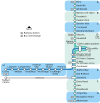
Operations OperatorsStagecoach Group · Transport for Greater ManchesterVehiclesFlexity Swift M5000 · T-68History Former operatorsTransferred linesClosed stationsAbandoned plansUnder Construction Bury LineQueens Road
East Manchester LineAshton Moss · Ashton Under Lyne · Ashton West · Audenshaw · Cemetery Road · Clayton Hall · Droylsden · Eastlands City Stadium · Edge Lane · Holt Town · New Islington · Velopark
Oldham & Rochdale LineCentral Park · Derker · Failsworth · Freehold · Hollinwood · Kingsway · Monsall · Milnrow · Newbold · Newton Heath and Moston · Newhey · Oldham Central · Oldham King Street · Oldham Mumps · Rochdale railway station · Rochdale Town Centre · Shaw & Crompton · South Chadderton · Westwood
South Manchester LinesBaguley · Barlow Moor Rd. · Benchill · Burton Road · Crossacres · Didsbury · East Didsbury · Hardy Farm · Haveley · Hough End · Manchester Airport · Martinscroft · Moor Road · Northern Moor · Peel Hall · Robinswood Road · Roundthorn · Sale Water Park · Shadowmoss · West Didsbury · Withington · Woodhouse Park · Wythenshawe Town Centre · Wythenshawe Park
Proposed Bury LineBuckley Wells
Trafford Centre LineImperial War Museum · Lostock Parkway · Manchester United · Parkway Circle · Port Salford · Salford Reds · Trafford Centre · Trafford Quays · Village
Stockport LineGorsey Bank · Heaton Mersey · Kings Reach · Stockport Interchange
Second City CrossingExchange Square
Transport for Greater Manchester · UK light rail systemsCategories:- Network Rail managed stations
- Former Great Central Railway stations
- Former London and North Western Railway stations
- Former Manchester, South Junction and Altrincham Railway stations
- Railway stations in Manchester
- Railway stations opened in 1842
- Railway stations served by Arriva Trains Wales
- Railway stations served by CrossCountry
- Railway stations served by East Midlands Trains
- Railway stations served by First TransPennine Express
- Railway stations served by Northern Rail
- Railway stations served by Virgin Trains
- DfT Category A stations
- British Transport Police stations
-
Wikimedia Foundation. 2010.









